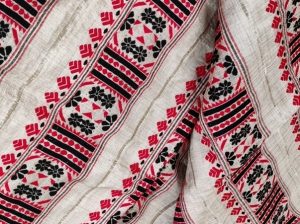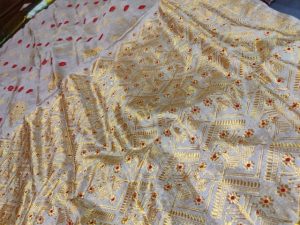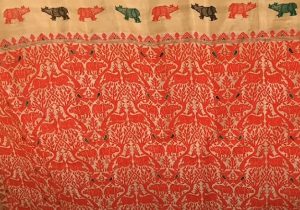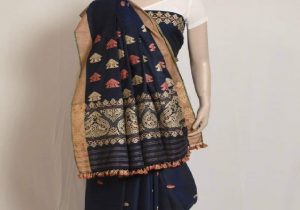SIGN UP FOR NEWSLETTER
Be the First to Know. Sign up to newsletter today

Guest Blogger
487 views
add comment
When we think of India, we think of unity in diversity. From languages and attire to food, ethnicity & cultural practices, you cannot find any other country that is as diverse as India. This diversity also reflects in its textiles & crafts. The textile heritage of the country is rich, with an amazing variety of fabrics, weaving & dyeing techniques that are unique to each region or State in India. One such diverse heritage is with regard to sarees. While the Kanjivaram silk sarees & Banarsi silk sarees are well known, the Assam Silk sarees, especially the traditional Assam Muga Silk sarees, are relatively unknown. Yet, they are of themselves of a very fine heritage.

The State of Assam is in the North East region of India. Assam is known for the one horned Rhino in the famous Kaziranga National Park.Assam tea is also popular worldwide. In addition, the stunning silk textiles of Assam hold a unique place in the silk map of India.Pat silk, Eri silk, Kesapat, Tussar and Muga Silk are some of the names of the multiple varieties of silks available here.The texture of each silk fabric is very unique.

Assam Muga Silk Sarees
The golden thread of Muga silk holds a pride of place among the countless varieties of Assam silks. It is also called the ‘Queen of silks’. It is one of the rarest silks of India and is produced only in Assam. Muga in Assamese means yellow or golden. Muga silk is made from the silkworms ‘Antheraea assamensis’ which are semi-cultivated silkworms. Further, it is known as one of the strongest natural fibres.
According to historical records, the weaving of Muga silk can be traced back to the Ahom Dynasty in the 13th CE. Several looms of Muga were under royal patronage and were famously known as Rajaghoria looms.

What makes Muga stand out is the durability & smooth texture of the golden silk fabric. It is extremely soft and highly lustrous. Another significant property of this fabric is its longevity. It is believed to outlive the wearer, thus making it an heirloom piece. In other words, the traditional Assam Muga silk can be passed down from one generation to another.
The silk worms are mostly cultivated in the Garo Hills of Assam. Normally, it takes about 1000 cocoons to produce 125 grams of silk. Further, about 1000 grams of silk are needed to weave one saree. The average production is 400 grams of silk on worms reared in one acre of land. So one can understand why Muga silk is expensive. In addition, the extraction process is very time consuming and it requires special skills. As a matter of fact, the silk thread acquires a rich golden yellow or light brown colour depending on the season.

Assam Muga Silk Sarees
As is the case for any silk, the female silk moths lay eggs. The eggs are hatched in a clean environment under controlled temperature conditions. The larve or caterpillar are fed on leaves of plants like mulberry, oak, castor plant, Som, Sualu, Mejankari & Pan-chapa. After 30 to 40 days, the silkworm larvae stop eating the leaves.This is when they start to spin cocoons around them.These cocoons are the main source of silk. The silkworms develop into a silk moth inside the cocoons.
Sericin is the gum which makes the silk fibres stick together in cocoons. So, normally, one has to degum the cocoon to get the silk fibre. This process is called ‘Degumming’. In this process, the cocoon is exposed to the sun or is steamed or boiled. But in Assam silks, the degumming process is avoided, especially for pure Muga, Kesapaat and Tussar, as it strengthens the fibre. This is a non violent way to extract silk. The silk fibre is simply unwound from the cocoon.The silk fibre is then converted to silk threads. This process is called ‘Reeling’.Once the yarn is derived, it is mostly woven into 6 yard sarees, shirts, stoles and other garments. Exquisite resham embroidery is done on the fabric with colourful threads or Zari. Oftentimes, the embroidery is of flora & fauna. The rhinoceros motif on the saree is rare & is indeed magnificent .
The traditional garment of Assam is ‘The Mekhla Chador’. This is a skirt and a sarong which is an unstitched fabric.For instance, women prefer to wear the Mekhla Chador at traditional functions. Traditional Assam silk sarees & garments can be purchased at Sualkuchi Textile Park. It is the most popular weaving centre in Assam. It is about 40 kms from the capital city of Assam, Guwahati.

Tani Bhattacharjee
Another Assam Silk saree manufacturer & shop is “Saree Mantra” run by Tani Bhattacharjee. She is a descendant from a family of weavers. She quit her corporate job to take over the family business and runs her own line of specialty sarees, traditional garments & fabrics in Assam silks .
Tani Bhattacharjeee +917896541489
Facebook Id :- Sari Mantra | Sualkuchi (facebook.com)
Instagram Id :- Tani Bhattacharjee (@sarimantra_) • Instagram photos and videos
Shop for Muga Silks in Delhi & Kolkata. They are available in the Government Emporium.
Author:

Dr. M. Kanaka Durga
Related Blog:-
11 Eponymous Silk Sarees from Indian States
Be the First to Know. Sign up to newsletter today
Beautifully written- love the history and the background ! Now, I have to get a Muga silk sari or stole !!